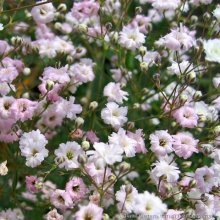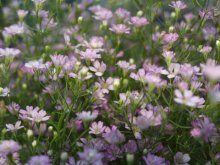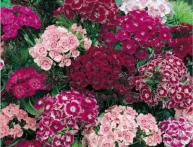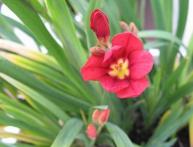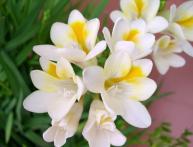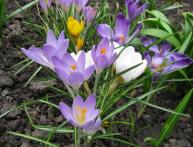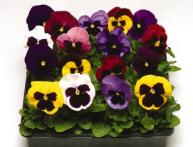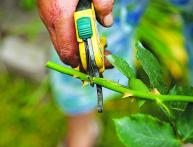Dance of white moths: Gypsophila paniculata
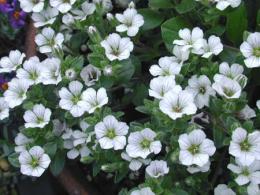
It seems that the entire plant is surrounded by a snow-white ball made of the wings of white moths, hidden during the flowering of the plant. As soon as florists from different countries did not call it. For the British it was “baby’s breath.”
The Germans called it the “bridal veil.” In Mediterranean countries it was a Levantine soap root, which was used for washing delicate fabrics due to its ability to foam water without the help of the chemical action of alkalis. Among the steppes of southern Russia you can find a snow globe, driven by the wind across their expanses, consisting of boxes with seeds called “tumbleweeds”. And this is also gypsophila.
A plant that grows in mountains, steppes, and other not very convenient places, even on rocky slopes. Perennial The carnation genus has over a hundred species. The seeds of some of them can be purchased at flower shops. The use of a flowering plant in the design of bouquets in order to give them an airy lace look has led to the emergence of great interest in growing it in summer cottages. Any advice from experienced flower growers will be especially useful for beginners.
Content:
- Appearance of gypsophila paniculata
- Varieties of gypsophila paniculata
- Growing and propagating gypsophila paniculata
Appearance of gypsophila paniculata
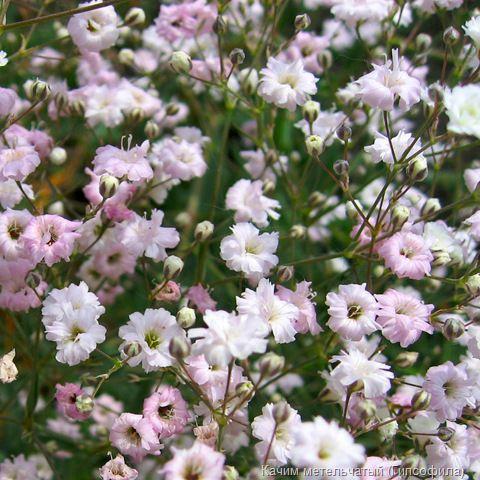
- To choose the right planting site, you need to know that this herbaceous perennial plant reaches up to 1.5 m in height with proper care.
- The knotty stems of gypsophila provide very strong branching, especially in the upper part of the bush. It is this property that ensures the creation of a beautiful bush shape in the form of a round openwork ball.
- The lance-shaped, gray leaves have a pubescent edge that gives them a delicate velvety appearance. They are located at the bottom of the bush.
- Paniculate inflorescences consist of numerous small white or pink flowers that appear in July and decorate the plant for about 50 days.
- Then, instead of them, boxes with seeds are formed. The wind helps to open them and carry them over long distances. Nature itself solved this issue of plant propagation. The seeds are very small, but there are many of them and their germination persists for three years.
Numerous garden forms of gypsophila There are also varieties with double flowers. In addition, they are larger, which makes the whole bush even more mysterious. When growing terry varieties, it is necessary to take into account that both the number and percentage of germination of their seeds is significantly lower than that of ordinary gypsophila.
The plant is a winter-hardy species. Only certain garden varieties require shelter. Any flower garden can be decorated and created the appearance of a delicate cloud with the help of several gypsophila bushes. Moreover, you can grow not only perennial species, but also annual ones, which allow you to fill the free space among already growing flowers.
Flowering begins from the lower branches, but after a week the entire inflorescence is formed. In autumn, the bushes are pruned, leaving a few stems.
Varieties of gypsophila paniculata
The perennial variety of gypsophila is most often grown for cutting and used in various compositions when making bouquets. The most popular varieties are:
- Gypsophila "Terry" with white double flowers, up to 1.5 m high.
- Gypsophila 'Bristol Fiery' with pink double flowers. The size of the bush is one of the largest.
- Gypsophila "Rosenschleier" is a creeping variety and has a height of up to 40 cm and pale pink double flowers.
- Gypsophila "Pink Star" with very bright flowers.
- Gypsophila "Rosie Veil" with a height of 40 cm and white petals.
All varieties of gypsophila give complete integrity to any flower arrangement. Even a dense bouquet of powerful inflorescences, such as lilies, will become airy and especially festive.
Growing and propagating gypsophila paniculata
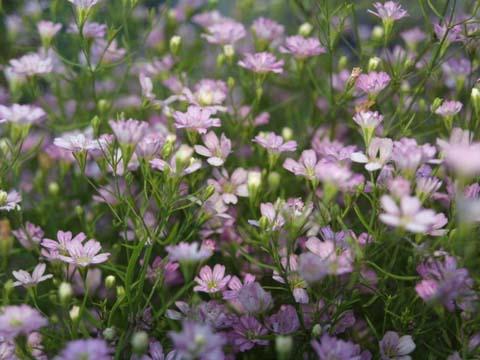
The main requirements for successfully growing a plant are the strict implementation of certain agrotechnical measures. These include the correct choice of soil, moderate humidity, good lighting, and the absence of transplants that it does not tolerate.
- Location and lighting. For planting, it is necessary to use a sunny place on the site without close groundwater.
- Watering and fertilizing. The plant loves abundant watering without stagnation of water. The first feeding is done in the spring with manure and nitrogen fertilizers. It is especially important to water all the bushes with urea solution during their budding.
Seed propagation perhaps in spring and autumn directly into the ground. The ridges are prepared on light loamy or sandy loam soil containing lime. The plant should not be planted in acidic soils. Dolomite flour and ash must be added annually.
It is advisable to add humus before planting, but without fresh manure. Good drainage is a must. Before germination, the soil on the ridges should be slightly moist.In case of stagnation of water, the roots dry out very quickly and the plant dies.
These plants are transferred to a permanent place only next year. You can grow seedlings at home. To do this, the seeds are sown in April in special boxes under glass. They keep them at home. The plant is planted in a permanent place only after the first true leaf appears.
Plants grow quickly, so no more than three plants are planted per square meter, which can remain there for 20 years. In October, all young bushes should be covered with earth, the stems should be bent and covered with spruce branches.
Grown bushes only up to two years old can be transplanted to another place. To do this, very carefully in the spring they dig up the entire bush, as deep as possible. The main thing is not to disturb the long taproot. Any damage to it causes the death of the plant.
In addition to seed sowing, gypsophila can be propagate by cuttings and vaccination.
Cuttings are the simplest and most reliable method, although they require certain skills. Due to the low survival rate of the plant, all cuttings taken in the spring must be treated in a heteroauxin solution. Covered with jars, the plants are darkened and carefully watered regularly. Grafting is used when propagating rare varieties with a minimum amount of planting material. The process of grafting a cutting onto an old root is very complicated and is used only by experienced gardeners.
In addition to the beautiful airy bushes that you can admire in the summer, the healing properties of the plant can also be useful. Moreover, they have been known for a long time and have been tested by time. Gypsophila is considered a real storehouse of saponins. Scientists in England are researching its properties to combat leukemia.
Treatment of skin diseases, relief of rheumatic pain, swelling, ability to thin phlegm in expectorants, laxative and analgesic effects of gypsophila have not yet been fully studied. Traditional medicine uses it in many of its recipes. And in the future, this flower, a symbol of caution, will reveal its secrets in helping people in many ways.
Interesting video about gypsophila:
Interesting information about the vegetable garden

